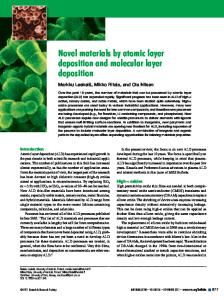Controlling Area-Selective Atomic Layer Deposition of HfO 2 Dielectric by Self-assembled Monolayers
- PDF / 144,546 Bytes
- 6 Pages / 612 x 792 pts (letter) Page_size
- 68 Downloads / 392 Views
D3.3.1
Controlling Area-Selective Atomic Layer Deposition of HfO2 Dielectric by Self-assembled Monolayers Rong Chen1, Hyoungsub Kim2, Paul C. McIntyre2, Stacey F. Bent3 1. Department of Chemistry, 2. Department of Material Science and Engineering, 3. Department of Chemical Engineering, Stanford University, Stanford, California 94305 ABSTRACT A series of self-assembled molecules have been investigated as deactivating agents for the HfO2 atomic layer deposition (ALD). Three important factors of self-assembled monolayers (SAMs) deactivating efficiency towards ALD--chain length, reactivity and steric effect--have been investigated and discussed as well as the initial blocking mechanism of this process. This investigation shows that in order to achieve satisfactory deactivation, it is crucial to choose high reactivity, low steric effect molecules with certain chain length to form condensed, high hydrophobic organic monolayers. INTRODUCTION As the lateral dimensions of MOSFETs continue decreasing and higher switching speeds are required, the thickness of the SiO2 gate dielectric must be substantially decreased to a few atomic layers.1 However, the leakage current caused by the direct electron tunneling from gate to the channel increases exponentially with decreasing dielectrics thickness [1-3]. In order to solve this problem, gate dielectrics with permittivities greater than that of SiO2, such as HfO2 [4], are required. High-κ dielectric layers allow deposition of thicker layer while retaining the same capacitance equivalent to the thin SiO2 layers. Among many possible deposition techniques for depositing ultrathin high-κ dielectric films, atomic layer deposition is very promising. The adsorption-controlled layer-by-layer reactions form excellent conformality and uniformity [5]. At the same time, ALD gives a way where surface reactions play an important role for both surface nucleation and film growth. ALD process is based upon chemical reactions between the precursors and the film surface, and the reactions strongly depend on the specific reaction functional groups present prior to the deposition. One of the difficulties with ALD, however, is that controlling and, in particular, preventing the deposition. Blocking the ALD chemistry at a surface is necessary in a number of applications, including production of an ALD resist for patterning and development of an area-selective ALD process [6,7]. The area-selective ALD process differs from conventional lithography in that rather than a subtractive process, it is an additive process in which material is deposited only where needed. Because of this distinction, area-selective ALD would provide a number of advantages, including reducing the number of etch and lithography steps for system utilizing multiple depositions, eliminating difficult etching steps (such as high-κ gate dielectrics), and minimizing the use of expensive reagents. Here, we report on the modification of a silicon substrate to block HfO2 high-κ metal oxide gate dielectrics by using metal chloride and water pr
Data Loading...










